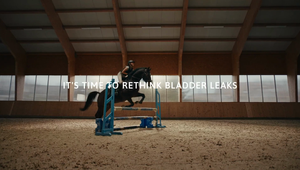
Magic Numbers: How Robyn D’Arcy Finds Brands’ Their Place in the Zeitgeist

Throughout her career, Robyn D’Arcy has married data with strategic and creative vision, driven by the conviction that the best ideas come from the best insight. As head of data at UK creative agency AMV BBDO, Robyn leads a team that analyses and makes actionable social, search, web, survey, and cultural data, taking a multifaceted, 360-degree approach to strategy across the majority of the agency’s clients.
A Data IQ under 30 and Pitch 100 winner, she has had her data journalism published in both trade and consumer publications, including Creativebrief, Creative Salon, BITE, Cosmopolitan, Marie Claire and The Huffington Post.
Robyn believes that data works best when it’s incorporated from the beginning of the creative process, uncovering insights that may not otherwise have been considered: most importantly, how, when, where, and why audiences think about a brand, a need it delivers, or an association they have with it. For her, the most award-winning campaigns centre around a human truth, and the best ideas come from the best insight.
LBB’s Alex Reeves asked her about her views on the many roles data plays in AMV BBDO’s work with brands.
LBB> What’s the number one question that clients are coming to you with when it comes to how they can better use data to enhance the creativity of their content and experiences?
Robyn> Currently, I’d say the most common questions centre on analysing the zeitgeist: identifying a brand’s current and aspirational positioning within culture, benchmarking against competitors, and finding whitespaces: new audiences, conversations and trends we should be tapping into.
We developed our ‘Place in the Zeitgeist’ product because we knew clients wanted to anchor their creative work in an understanding of how they’re being positively and interestingly portrayed. This informs creative ideation and inspiration from multiple angles. We’ve gained unique insight by analysing the lyrics and genres of songs that reference a brand, we’ve formed moodboards from non verbal appearances of another brand on TV and in film, and we’ve tracked the memeification of key products across social media.
And doing so in ways that are real-time and reactive is key to being relevant.
LBB> How can you make sure that data is elevating creative rather than forming a wind tunnel effect and knocking all the interesting or unique edges off that make something distinctive?
Robyn> Firstly, by changing the perception of what data is. Data is often seen reductively, as code, conversions or numbers in an Excel, but when done correctly, it elevates creative by quantifying and adding texture to conversations, associations, feelings and perceptions. Secondly, by taking that through to methodology: data should be inherently creative in both input and output.
That doesn’t mean not being methodological, going wildly off brief or not maintaining accuracy; it means including relevant sources and cutting the data in ways that tell an interesting story.
For instance, when working on campaigns around quitting nicotine with Nicorette, it’s obvious that vaping is perceived negatively. However, we didn’t previously quantify the extent to which vaping is associated with ‘cringe,’ similar to how smoking is often linked to shame. We now know that, beyond anything else, vaping is described most as both a way of ‘dating’ 2023 as a period in time, and as a defining symbol of cringe culture. We didn’t know that of the 3,573 published songs with vaping in the lyrics, vapes as a point of comparison and derision was the most prominent theme of reference. And we didn’t know that 84% of references to vaping on screen appear in comedies, with vaping as the butt of the joke, compared to 16% of smoking appearances.
Sometimes it’s also worth looking beyond the category, and comparing apples to oranges. For instance, as part of our work for Refuge, we are all too aware of the rates of intimate partner violence, and the fear victims live with. But we didn’t know that women search on Google about being scared of a male partner more than they do around fears of spiders, the dark, or death.
We don’t want to completely jettison the ‘obvious’; we just also want to amplify the unknown.
LBB> Can you share with us any examples of projects you’ve worked on where the data really helped boost the creative output in a really exciting way?
Robyn> One of my favourite examples is our ongoing work for SHEBA, based on tracking the emotions a target audience holds towards something, and segmenting when, how, where and why they feel this way. In the case of SHEBA, this meant analysing social conversations and searches from cat parents and pinpointing the emotions that they feel, and how they perceive their cat to be feeling, over hours of the day and months of the year.
We also recently brought our trend tracker methodology onto SHEBA US social channels, monitoring on an always-on basis the trends and discussion driving engagement. From this, we then identify opportunities for SHEBA to join the conversation, in ways that align with the seductive, irresistible SHEBA branding. Most recently, our feline re-enactment of Jeremy Allen White’s Calvin Klein campaign.
LBB> More brands are working to create their own first party data practice – how can a brand figure out whether that’s something that is relevant or important for their business?
Robyn> By establishing their intention, and keeping consistently in mind the reason behind value exchange between consumer and brand. What value does a consumer gain from providing us with their data? What can we offer to them in a way that is distinctly on brand? And this starts with first understanding the audience: how, when, and where are they most likely to resonate with us, and benefit from entering into this exchange?
It’s also important to consider taking an always-on approach; how can we keep measuring their interactions and response with us, and how can this deliver life-long value?
Obviously, weighing up variations in regulations across different markets is also crucial.
LBB> We talk about data driving creativity, but what are your thoughts about approaching the use of data in a creative way?
Robyn> One of the main pieces of work that drew me to AMV was 2021’s Addresspollution.org campaign; I thought it was a brilliant example of aligning a dataset that most us may not have front of mind – air pollution – with a dataset based on what we do care about: house prices.
The platform allowing people to plug in their postcode and see how their home compared was genius, as was the seamless journey to sign a petition demanding change. As soon as I checked my own postcode, I sent it to a bunch of people as an example.
LBB> "Lies, damned lies, and statistics" - how can brands and creative make sure that they’re really seeing what they think they’re seeing (or want to see) in the data, or that they’re not misusing data?
Robyn> By accepting that sometimes the lack of data is the insight itself. A lack of information to gather gives you insight on what is not considered ‘worth’ collating, or invokes barriers preventing people from talking about it. For instance, the data gap around women’s health gives undeniable insight around the lack of attention given to illnesses that impact predominantly women. Similarly, a lack of open conversation about particular health issues speaks to a sense of shame, or lack of knowledge.
Prompted data collection, like surveys, are brilliant for pulling nuance on under-exposed topics, whilst segmenting search data uncovers the fears and embarrassments we wouldn’t post about.
Ultimately, there’s little point analysing what is statistically insignificant. And equally, there’s little point even trying to pull data to back up an hypothesis that isn’t accurate.
But there is always a way to get insight, if you come from a different angle, and consider what a lack of information could actually be telling you.
LBB> What are your thoughts about trust in data – to what extent is uncertainty and a lack of trust in data (or data sources) an issue and what are your thoughts on that?
Robyn> To me, this all hangs in the sources gathered and the methods of cutting the data. AMV’s ‘open API’ approach is key; we analyse multiple sources, using various tools, coding languages and methodologies.
You need to be looking in the right places. There’s no point in saying X% of gen z in the UK think Y about a brand, if you’re ignoring TikTok. There’s no point saying the biggest news story engaging millennial women is X if you haven’t analysed Spotify podcasts. And there’s no point claiming to understand people suffering from chronic health issues that are tied to taboo if you haven’t analysed blogs that allow anonymous posting.
LBB> With so many different regulatory systems in different markets regarding data and privacy around the world – as well as different cultural views about privacy – what’s the key to creating a joined up data strategy at a global level that’s also adaptable to local nuances?
Robyn> Transparency and adaptability. Being aware of market nuances beforehand and having this knowledge plugged into the planning phase of every project. Beginning with a data audit per market is always a strong starting point.
LBB> What does a responsible data practice look like?
Robyn> One that champions clarity, particularly within first party data collection and performance reporting.
LBB> In your view, what’s the biggest misconception people have around the use of data in marketing?
Robyn> That it’s boring, and distinct from creativity. We’re establishing new ways to present ‘data theatre’ with outputs that are as engaging and interactive as they are informative.
LBB> In terms of live issues in the field, what are the debates or developments that we should be paying attention to right now?
Robyn> Probably the debates around synthetic data and, obvious as it is, ethical AI. Not simply in regards to copyright, plagiarism and fears of waning originality, but also how it impacts people’s lives, beyond their livelihoods. Irresponsible use of AI has already caused irrevocable harm to those whose likeness is stolen, and as data and innovation professionals, we should be using our expertise and voices to call this out.















